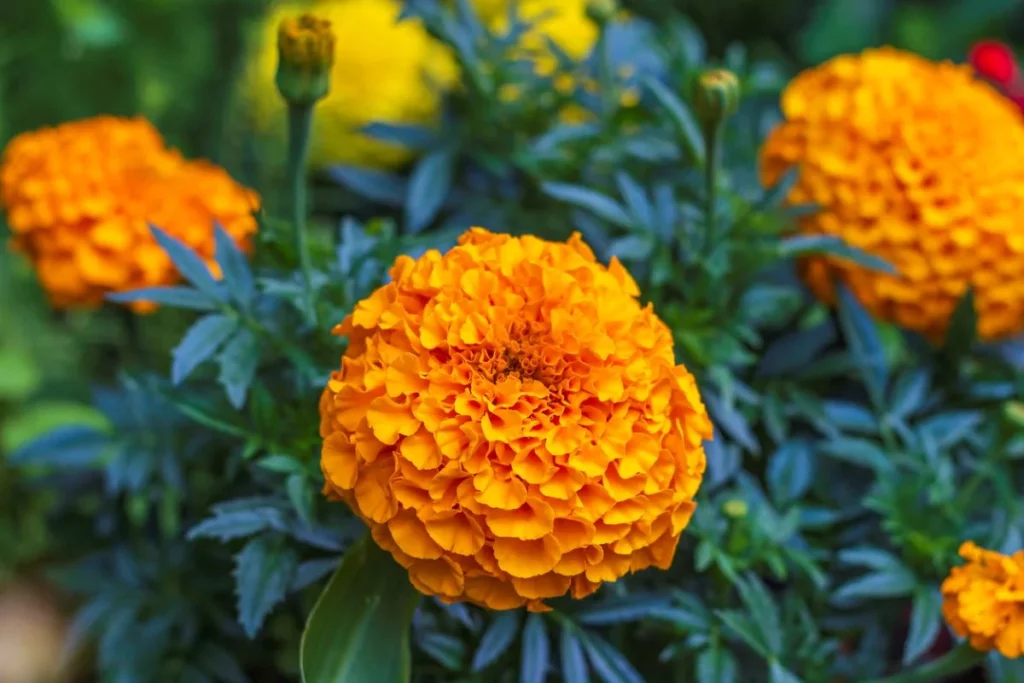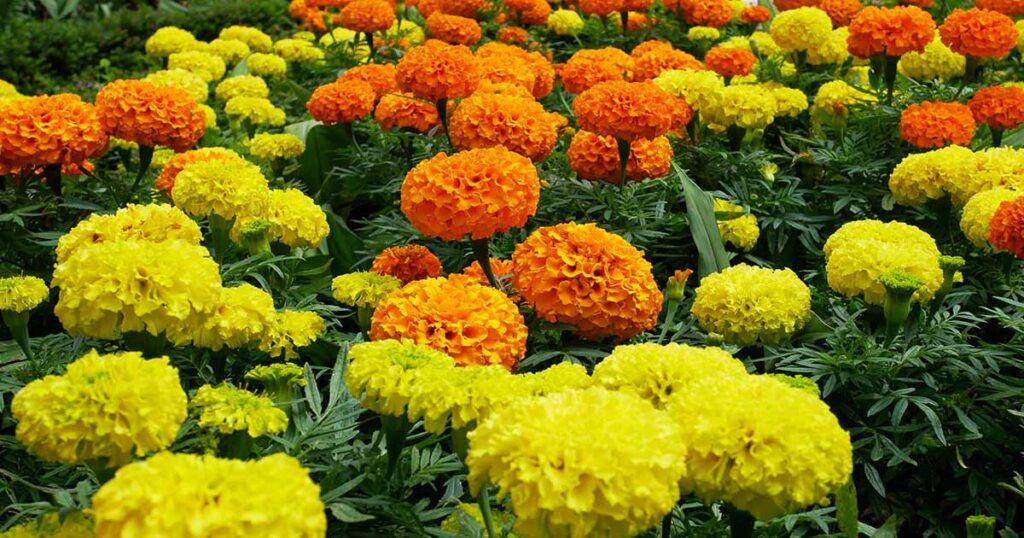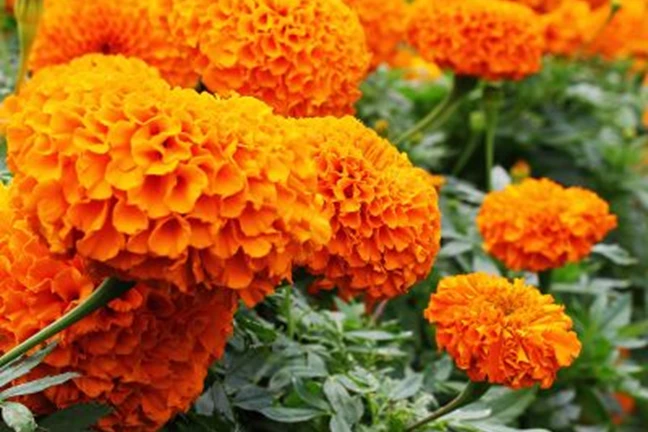
Yes, marigolds are edible and used both fresh & dried in culinary dishes. Depending on the variety, the taste and flavor differ slightly, but make your dishes tasty and flavorful.
Though most marigolds are edible, few wild varieties contain toxic substances. If you consume these flowers, these chemicals can harm your stomach and lung function. To avoid such health issues, check out the edible varieties and use them in food decoration and culinary dishes.
Still confused about marigolds? Go through our detailed guide to use edible varieties for delicate and mouth-watering dishes.
Are Marigolds Edible?
Most of the Marigold species are edible and offer aromatic flavor with a slightly spicy taste. Besides, petals and leaves are edible and offer a pleasantly mild flavor with many tasty dish options like salads, cakes, soups, stews, and braise.
Moreover, marigold leaves are rich in carbohydrates and fiber, perfect for a high nutritional diet. Also, petal includes quercetin, an excellent antioxidant, and anti-inflammatory that can reduce swelling, control blood sugar, and prevent heart diseases.
However, few wild varieties contain toxic compounds which are highly harmful to health. It is better to check the variety and use only the edible ones for culinary purposes.
How Do Marigold Taste Like?

Marigold taste depends on species, variety, and flower parts. Let’s start with the Irish lace marigold or Dropshot (T. filifolia). Though rare in gardens, Dropshot is an edible herb with flavorful leaves. Due to its citrus and anise flavor, it is perfect for various recipes.
Next, the Lemon and Tangerine Gem (T. tenuifolia) comes with a bitter petal and citrus flavor. Even the cultivar offers a slight orange flavor with a hint of anise. The licorice or Mexican mint (T. lucida) gives the same as the Tangerine Gem with its anise-like flavor. But the yellow flowers of the species smell like an herbal product.
According to Gardernspath, species like Pink Surprise (C. Officinalis) and Queen Sophia (T. Patula) are ideal for coloring abilities. Besides, the extract enhances the dish’s color rather than increasing flavor. Still, Pink Surprise offers a pleasantly mild flavor with many tasty options.
What Are The Edible Parts of Marigold
Petals and leaves are the only edible parts of marigold. Depending on the flavor and taste, the uses of the edible parts vary a lot. Let’s have a look at these parts in detail.
Petals
For various purposes, it is the most used part of marigolds in the kitchen. Petals are ideal for both fresh and dried uses in culinary dishes. Due to its vibrant color, petals are perfect for salads, cakes, soups, stews, and braises. Besides, the strong flavor with a slightly spicy taste can make your dishes delicate and mouth-watering.
The petal includes a pigment known as quercetin, an excellent antioxidant and anti-inflammatory. As a result, these petals can reduce swelling, control blood sugar, and prevent heart diseases.
Leaves
Compared to petals, marigold leaves are less used in culinary applications. The slightly aromatic flavor of tender leaves is widely used in a green salad and herbal tea. Some species offer citrus and anise flavor leaves, perfect for soups and stews. Also, the leaves are ideal for adding color to several dishes as an attractive garnish.
On top of that, marigold leaves are rich in carbohydrates and fiber, ideal for a healthy diet. Hence, try a small amount in the dishes to satisfy the aromatic and nutritional requirements.
How Can I Use Marigolds In The Kitchen?

If you’re dealing with kitchen uses, marigold offers versatility, including garnishing dishes, food decoration, herbal products, flavor addition, butter, and presto. Let’s dig into the uses in detail.
Garnishing Dishes
Both fresh and dried petals are ideal for culinary dishes. Now, the vibrant colors of the petals are perfect for garnishing salads, cakes, soups, and desserts. Besides, the spicy taste with strong flavor gives you mouth-watering dishes.
Food Decoration
Colorful ingredients can take the decoration to a different level if you’re decorating cakes and desserts. Instead of using chemical colors, Marigold’s bright orange and yellow petals can enhance the visual of dishes.
Herbal Tea
Due to the slightly aromatic flavor, tender marigold leaves are widely used in herbal tea. Just steep the leaves and petals in hot water to create a healthy and aromatic drink.
Flavor Addition
Most species offer a subtle and slightly peppery flavor to meet the aromatic requirements of dishes. Some species provide citrus and anise flavor leaves, perfect for soups and stews.
Butter & Pesto
Marigold soft butter is perfect to add flavor to pasta or veggies. If you want healthy butter for morning bread, marigold butter is a delicate and flavorful option. Also, a proper blend of marigold with other pesto ingredients is ideal for serving with grilled meat or fish.
Infused Oil
While using the strained marigold-infused oil, try to keep it as dressings or drizzle over dishes. Steep the marigold petals to infuse the oil and store it in an airtight jar for longer use.
How To Grow Edible Marigold?

For growing healthy edible marigolds, choose the proper variety, select a suitable location, prepare the soil, plant seeds, and water regularly. Let’s go through these steps in detail.
Choose the Edible Variety
If you’re planting marigolds for eating or culinary purposes, choose edible variety like Irish lace marigold or Dropshot (T. filifolia), Tangerine Gem (T. tenuifolia), Mexican Mint (T. lucida) or Pink Surprise (C. Officinalis). Check the taste of edible varieties for specific tastes or flavors to pick suitable ones.
Select Suitable Location
Growing healthy marigold flowers requires at least 6 to 8 hours of direct sunlight daily. It helps in vegetative growth, flower formation, and flower production. Hence, select an elevated, sunny spot with enough sunlight for maximum yield.
Soil Preparation
After field selection, prepare the soil for plantation. If you’re planting in a garden, use slow-release fertilizer in the planting hole. Besides, mix sand with soil for better germination. On the other hand, if you’re planting on a pot, use a pot mixture or granular fertilizer for better growth.
Plant Marigold Seeds
Once the soil is warm and prepared, you can directly sow seed into the garden. In fact, use the line sowing method rather than broadcasting for optimum flower growth. If your environment isn’t suitable, Plantcare suggests germinating indoors to avoid germination failure. In the warm weather, seeds can sprout within a week.
Cultural Operations
Check out the soil condition before watering the plants. If the top inch is dry, use a nozzle or spout device for watering the plants. But flowers in pots or containers require daily watering as pots aren’t open chambers like a garden.
Harvesting
Marigold takes about 8 weeks to bloom, but picking flowers in full bloom is better. For various culinary needs, you can use the young leaves and petals. For harvesting seeds, pick flowers with dry and brown petals.
Warp Up
Marigolds are edible, but the taste and flavor differ slightly depending on the variety. Hence, these flowers are ideal for garnishing dishes, food decoration, herbal products, and flavor addition.
On top of that, leaves are rich in carbohydrates and fibers, whereas petal includes an antioxidant that reduces swelling and prevents heart diseases. However, few wild varieties contain toxic compounds that are harmful to health. So, pick edible varieties and enhance the flavor and taste of your dishes!